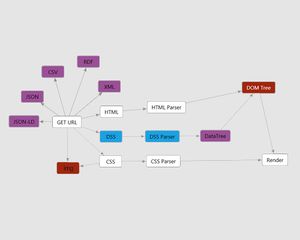Warning:
This wiki has been archived and is now read-only.
Main Page
From DataSheets Community Group
Contents
DataSheets Community Group
What is DataSheets?
- A new browser language that looks remarkably like CSS.
- You link to one or more .dss files within the <head> tag
-
<link rel="datasheet" type="text/dss" href="mainblog.dss">{proposed}
-
- In DSS you define where to get the Data as easy as you describe where to get the image to put into
background-image: url();within CSS- You get data with the property
data: url()
- You get data with the property
- You inject the data into the DOM using selectors
#table1 { data: url(); } - DSS provides templating using DOM and Shadow DOM. The HTML remains valid and not disturbed with mixins.
- You can consume all sorts of data. DSS will consume JSON, XML, CSV and other
- You can semantically define the data using existing standards.
- You can also define an element using selectors to attribute metadata
div p span.person { schema: url(http://schema.org/); type: "Person" }
- You can also define an element using selectors to attribute metadata
Goals
- To create the DataSheets language - DSS.
- To work with HTML, CSS Selectors, DOM, URI to create a language that can bind data to an HTML document and it's elements
- To negate the exclusivity of JavaScript as the only means to consuming data and dynamically applying it to elements.
- To facilitate the separation of 'HTML and Data' as 'HTML and CSS' has done.
- To facilitate web components and data components with Shadow DOM and Web Platform
- To aid in the creation of async enabled HTML by use of the
async, as in<input type='submit' defer /> - To bring the ease of CSS to data binding and templating
- To facilitate the consumption of data and Linked Data
- To facilitate semantic data
- To facilitate the browser's ability to understand data binding, storage and related functionality
Some Benefits
- Expose data consumption to a community for which JavaScript is not required
- Smaller/Cleaner HTML
- No mixing of data inside of HTML (HTMLTextElement)
- Providing a simplistic consumption strategy for all types of data and HTML templating
- Let the browser do the work for async forms
- Let the browser do the work in getting data and applying it to the DOM
- Data and Elements can be semantically described without other complicated semantic expressions
- A separate caching strategy for HTML, CSS and the Data would be possible
Topics
- The DataSheets language - DSS
- DSS and Data
- DSS and Schema
- XHR from HTML/DSS
Cross pollination Topics
- HTML <form defer> or <form async> syntax (async processing)
- HTML <a defer> or <a async> syntax (async processing)
- Consuming JSON
- Consuming XML
- Consuming Linked Data
- Consuming Schemas (JSON-LD, XSD, other)
- Semantic templating with RDF?
- Consuming other types of formats? (Markdown, CSV, microXML)
